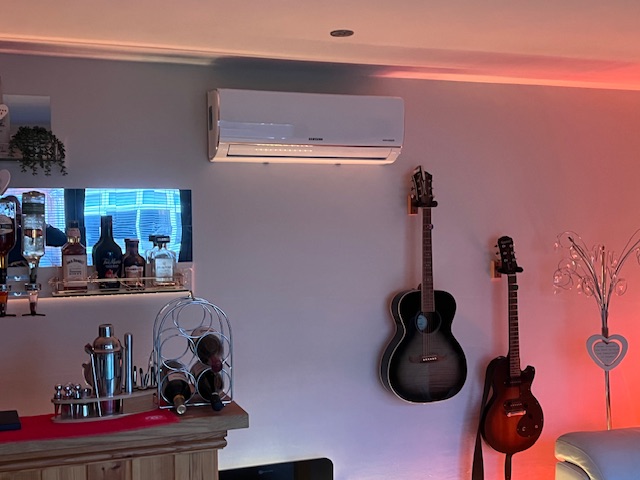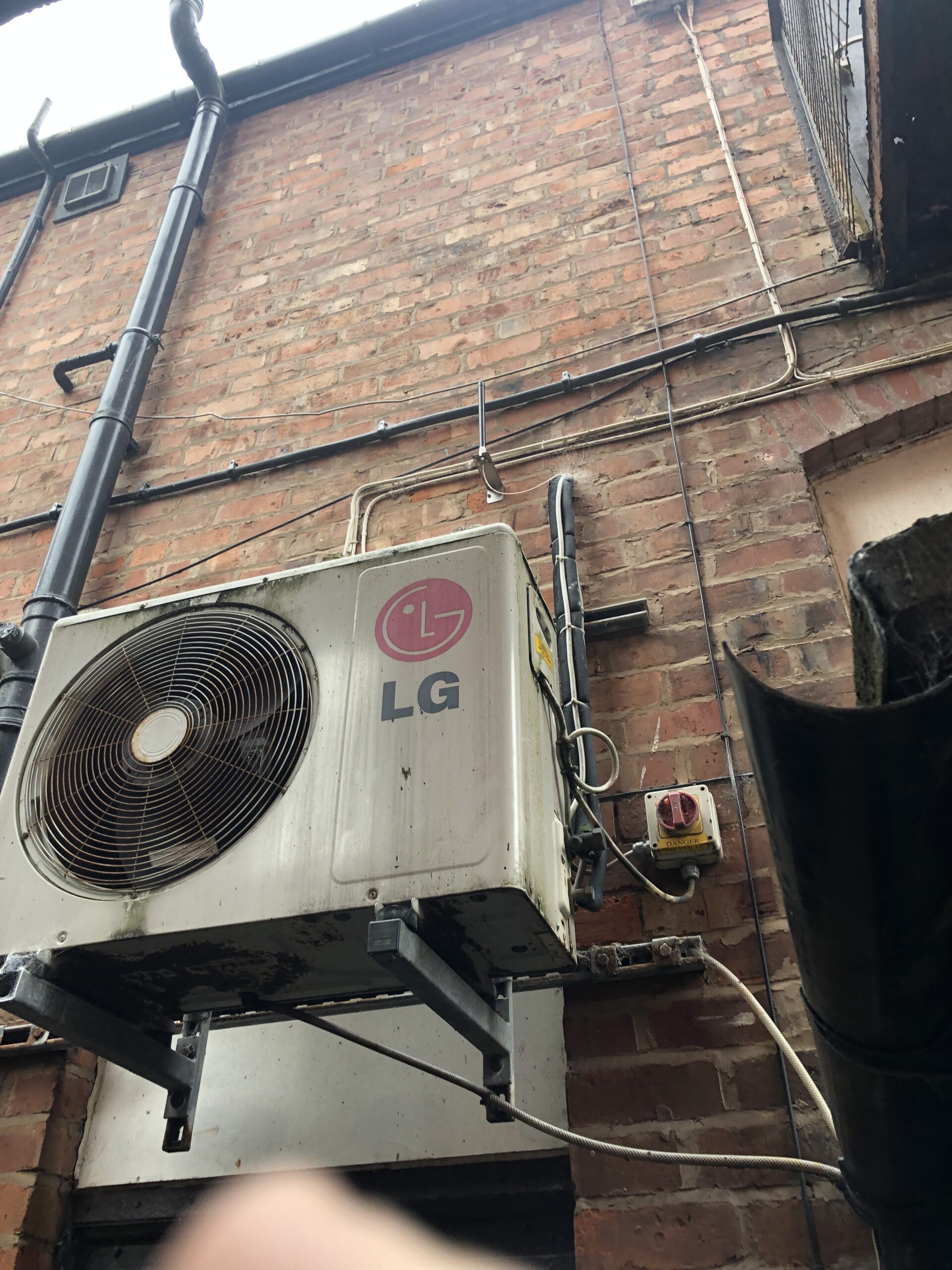Garden office air conditioning

Lovely air conditioning install in Southport
Old air conditioning replacement
 Why is it a good thing to replace your old aircon system . There are more advantages to disadvantages . Basically the draw back is the cost of a new unit , taking this into account the new system will offer you better return for your money . The gases used in the older units become replaceable over time by more efficient gases that are kinder to the environment and cheaper to run and offer better heating and cooling .
Why is it a good thing to replace your old aircon system . There are more advantages to disadvantages . Basically the draw back is the cost of a new unit , taking this into account the new system will offer you better return for your money . The gases used in the older units become replaceable over time by more efficient gases that are kinder to the environment and cheaper to run and offer better heating and cooling .
Air conditioning southport
Office air-conditioning supplied and fitted in southport

Areas Cool Heat cover
Below is a list of areas cool heat covers
Liverpool
Formby
Ainsdale
Hillside
Birkdale
Southport
Hesketh park
Meols cop
Marshside
Crossens
Banks
tarelton
Preston
Blackpool
St Annes
Machester
Chorley
Leyland
The Wirral
North Wales
Air-conditioning inspections
Air-conditioning inspections
Having your air-conditioning regularly inspected by an Engineer is designed to improve the efficiency , reduce electric bill and cut your carbon emissions at home, business .
Inspection Frequency
A annual inspection is recommended and most of the manufacturers insist it’s covered yearly to keep the warranty in place .
Efficiency
Energy inspections, , offer an opportunity for you to make sure that the system is performing as efficiently as possible and may highlight opportunities to replace older, less energy efficient systems or oversized systems with the new more energy efficient systems. Energy inspections may also identify units that are no longer required due to a change in use of parts of your building or home.
These energy inspections are in addition to the normal activities associated with the ownership and operation of air-conditioning systems. These include inspection, maintenance and cleaning programmes to maintain the ability of the system to provide healthy and comfortable environments for building occupants, limiting the escape of refrigerant gases and ensuring the safety
Lockdown Deal on Air Conditioning
During these tough times we’re offering huge discounts on the installation of Air conditioning installations , call us to discuss your cooling and heating needs we will compile a free design and quotation for you .
AIR CONDITIONING

Most companies have spent a lot of time explaining to people that air conditioning cools and heats , and not only does it heat, it does so more efficiently and with less energy consumption than traditional water filled radiator heating system.
Heat pump technology, is basically air conditioning in reverse. An air conditioning or refrigeration unit cools by taking heat from the inside of a building and moves it to the outside. A heat pump does the opposite and, in theory, as long as the outside temperature is above absolute zero, there is heat that can be extracted from ambient air. In practice, most heat pumps operate best above -20â°C.
“The Government classifies heat pumps as renewable energy for the purposes of its incentive scheme”
Unlike oil gas and normal electrical heating, which all output less in heat than the energy they consume, heat pumps typically produce 3.4 kw of heat for every 1kW of electricity consumed. For this reason, the Government classifies heat pumps as renewable energy for the purposes of its incentive scheme.
Some of the advantages of having heating and cooling coming from the same equipment are obvious. Many of us are used to setting the environmental controls in our cars to a temperature and the system decides whether it needs to heat or cool to achieve that, which is exactly what you can do in a building with a heat pump air conditioning system.
Some advantages are not quite so obvious. For example, traditional radiators are misnamed, as little of the heat they provide is radiant heat, most is provided by convection. They heat the air around themselves, which rises up to the ceiling, where it stays until it cools below the air underneath it, when it falls again. This means rooms are heated from the ceiling downwards. Older built buildings with tall ceilings are a particular problem.
As the room’s occupants are invariably at ground level, this means that occupants take longer to feel the benefit of the heating than is necessary. To heat a room to the required temperature in time for its use, the heating system has to come on an hour or more before it is due to be occupied.
“Heat pump systems can make a room comfortable for its occupants in a few minutes, eliminating the need to switch on the heating an hour before occupation”
An air conditioning system is designed to direct warmed air down towards the floor. While this will, of course, rise in the normal way, there will instantly be more warm air to replace it. For this reason, heat pump systems can make a room comfortable for its occupants in a few minutes, eliminating the need to switch on the heating an hour before occupation.
If the VRF system features heat recovery and is linked to ventilation, it will ensure the building has a constant supply of fresh air, without having to reheat, or cool, an indoor space that has been already heated or cooled. As the air goes out, the system recovers up to 80% of the heat from it, to use on the incoming air.
we have a very useful wireless remote control with an “I feel” button, which lets you set the desired temperature to be measured at the remote control itself, which means the setting relates to the room’s occupants rather than a wall-mounted thermostat.
Wrongly, in my view, many people still fit traditional radiators for heating and air conditioning for cooling only (despite the fact that all the units can heat as well). If this is the case, the air conditioning can be used on fan only to drive the heat down from the ceiling.
The same principle of air circulation also applies to sports halls, where ducted systems with multiple outlets drive warm air down more efficiently than hot air blasters or even radiant heaters.
One of the features of many educational establishments over the past few decades has been that they grow in an ad hoc way, with extra or temporary rooms being added as they are needed. Extending a water circulation radiator system is always a major undertaking, and may even require enlarging the boiler. On the other hand, adding a new air conditioning unit is often just a matter of wiring and running refrigerant piping.
One of the many myths about air conditioning is that it creates draughts. This may have once been true, but advanced modern systems diffuse the air to avoid this. In fact, the constant circulation of warm air eliminates a draught problem that occurs with radiators and the large windows that are prevalent in many educational establishments. The warm air near the ceiling comes into contact with cold windows on cloudy cold winter days, cools down quickly and falls as a chilly draught.
